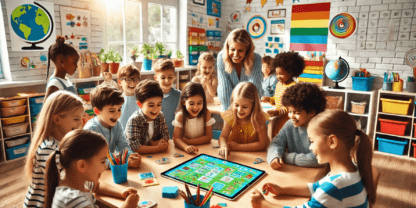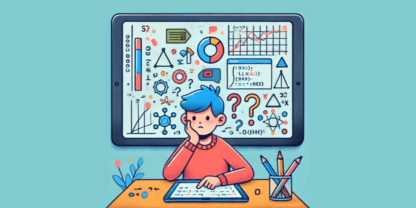In just over a year since ChatGPT’s launch, generative AI has ignited explosive discourse about its implications for education, frequenting headlines and stirring debate. Today, nearly every K-12 educational conference has keynote speakers discussing artificial intelligence. New products and tools are being released every month. Many educators seem to have adapted their mindset from initial fear to excitement about the transformative potential of this new technology.
But how are teachers really feeling about AI, and how much progress have they made integrating it into their teaching practice over the past year? In February, we sent a survey to thousands of PK-6 U.S. teachers to check in on their latest sentiments. The results shed light on the remarkable journey educators are taking. They’re navigating the complexities of AI with enthusiasm and curiosity, despite minimal formal training. Their dedication to enhancing educational experiences through technology is both impressive and inspiring—but our survey results show there is still a long way to go.
A leap in comfort and curiosity


In just one year, we’ve witnessed a significant leap in teacher comfort with using AI in the classroom, from an average rating of 2.9 (out of 10) to 5.6. This nearly 2x growth is not a product of structured training programs—66% of teachers report they haven’t received any formal instruction on leveraging AI for education. Instead, this appears to be a testament to their self-motivated exploration to stay ahead of the curve. Interestingly, only a small fraction (8%) reported trying AI at their school administration’s request, underscoring the current grassroots nature of this adoption.


The current state of AI integration
However, the path to fully integrating AI into teaching practices is still unfolding. Teachers today rate their experience with AI as 3.3 out of 5, indicating a cautious optimism. Most are experimenting with AI occasionally, with 73% only using it a couple times a year or monthly. This suggests we’re only beginning to scratch the surface of what true classroom integration could look like.


So, how exactly are teachers using artificial intelligence in their classrooms? Most cite lesson planning as their primary purpose, followed by personalized learning and assessment.


The tools and tactics teachers are using
- ChatGPT Dominance: A significant number of respondents mentioned ChatGPT as their most beneficial–and only–tool used for teaching. It’s used for a variety of purposes, including generating questions for reading passages, creating quizzes, lesson planning, writing letters, and more.
- Adaptive Learning Software: This category includes tools that adapt learning materials to the needs of individual students. Respondents noted these tools are transformative for personalized instruction, allowing for differentiation without overburdening the teacher.
- Creative and Planning Tools: Platforms like Canva and specific AI-powered lesson planning tools are saving teachers time and enhancing engagement in lesson preparation.
- Accessibility and Inclusion: Tools that help make learning materials more accessible were mentioned, such as using lower Lexile features for reading materials and tools for nonverbal students.
- Engagement and Interactive Tools: AI tools that create interactive experiences, such as music apps that create lyrics for chants and text to image generators are noted for their role in engaging students and enhancing learning experiences.
- Assessment and Feedback: AI’s role in generating assessments and facilitating personalized feedback is another area of growing interest.
Beyond the surface: A call for more exploration and support
Despite these advancements, there is a palpable desire among educators to delve deeper. They express a strong interest in learning about effective AI implementation strategies, tools for enhancing student engagement and personalized learning, and ways to foster critical thinking about AI outputs. Even amidst all the buzz, many teachers don’t have access to resources or knowledge on how to take AI adoption to the next level without it feeling like one more thing on their plate. As one teacher shared, “How can it really help my teaching without being simply another time consuming thing ‘to do’ because it’s the latest and greatest?” Another remarked, “I only know of a few AI resources, so I would love to know what’s out there for us to use as a resource.”
Our findings reveal a clear message: while teachers are making strides in incorporating AI into their classrooms, there’s a vast landscape of possibilities they feel are yet to be explored. Their enthusiasm for AI is tempered by a recognition of the need for more training, resources, and support in order to fully harness its potential.
Advice for educators, from educators
For those yet to embark on this AI journey, the advice from their peers is consistent: just try it. Start small, focus on specific needs, be curious, and don’t shy away from experimenting. Teachers emphasized the importance of seeking training and being critical consumers of AI tools. Most importantly, they encouraged others to use AI not just as a tool for efficiency, but as a catalyst for creativity and engagement in their classrooms. As teachers say it best, here’s verbatim advice shared in our survey:
- “Do it! It has been a gamechanger for me in lesson planning and I can’t wait to try some other things and have the kids participate.”
- “Explore and see what you might be able to use. There are a lot of tools out there and it might be overwhelming, but keep at it.”
- “The amount of time it saves me is invaluable. I have spent up to 10 hours planning out a week and with the help of AI it is drastically reduced with more engaging and creative lessons.”
- “Don’t jump in and try to revolutionize your entire curriculum overnight. Pick a specific area you’d like to improve, like personalized learning, automated grading, or creating engaging content. Then, research AI tools that target that specific need. Start with a free trial or pilot program to see how it works and if it fits your style. Seek out professional development opportunities to learn more about AI in education. Many organizations offer workshops, webinars, and online courses specifically designed to help educators integrate AI tools into their teaching practices… Most importantly, keep the needs and interests of your students at the forefront when exploring AI tools. Look for tools that offer personalized learning experiences, adaptive feedback, and opportunities for student engagement.”
Conclusion
As more educators explore and experiment with AI, the potential to transform teaching and learning becomes increasingly evident. With the right support and resources, the educational community can move beyond initial explorations to fully leverage AI’s capabilities, making learning more personalized, engaging, and inclusive. The constant dedication of teachers, evident throughout our survey results, is a promising indicator of their continued willingness to embrace the latest technologies and enhance their teaching practices in pursuit of student learning.
Get caught up on all the basics of AI in Education. Plus, subscribe to the EdTech Evolved newsletter to get tips, tricks, and best practices delivered right to your inbox.



